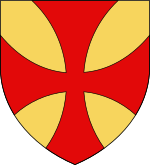Alice of Ibelin
Alice of Ibelin or Alix d'Ibelin (1325/1330 – after 1374)[1] was the titular Princess of Antioch as the second wife of John of Lusignan.
Alice | |
|---|---|
 Coat-of-arms of Ibelin. | |
| Born | 1325/30 |
| Died | after 1374 |
| Noble family | House of Ibelin |
| Spouse(s) | John of Lusignan, regent of Cyprus |
| Issue
Jacques de Lusignan, titular Count of Tripoli | |
| Father | Guy of Ibelin, seneschal of Cyprus |
| Mother | Margaret of Ibelin |
Family
Alice was born between 1325 and 1330, the eldest daughter of Guy of Ibelin, seneschal of Cyprus and Margaret of Ibelin. The House of Ibelin were an old, noble family which for two centuries had featured prominently in the Crusader States of Jerusalem and Cyprus. She had a brother, John, who later succeeded their father as seneschal; and a younger sister, Marguerite who probably died at a young age as she does not appear in any later documents.
Marriage and issue
In 1350, Alice married John of Lusignan, titular Prince of Antioch, who later became regent of Cyprus. She was his second wife; his first wife Constance of Sicily had died several years before, without having had children. A papal dispensation, which was dated 14 April 1350, was required for Alice and John's marriage.[2] The Lignages d'Outremer names Alice as having been John's second wife. She brought as her dowry, Alaminos, which she had inherited from her paternal grandfather, Philip of Ibelin.[3]
Sometime before 1358, Alice gave birth to John's only son and heir, James/Jacques de Lusignan (died 1395/97), titular Count of Tripoli, who married his first cousin Mary/Mariette of Cyprus and had five children. Phoebus de Lusignan was Alice's great-grandson as an illegitimate son of Jacques' son, Pierre. It was through Phoebus that Alice's direct line continued.
Alice's husband had an illegitimate son, Jean by his mistress Alix Gibelet.
She died sometime after 1374.
References
- Charles Cawley, Medieval Lands, Cyprus
- Cawley
- Cawley